If you’re curious about the American birthing culture during the majority of the 1900s, you’re in luck. BabyLand General Hospital, the birth place of the iconic cabbage patch dolls, is a unique time capsule not only for the children of the 80s, but also, unfortunately, the height of the medicalization of childbirth in the United States.
Much to the delight of visiting “adoptive parents” – their wording, not mine, for their audience of impressionable young children – BabyLand puts on a show multiple times per day of Mother Cabbage “giving birth” to a cabbage patch doll. Yes, it’s as intriguing and odd as one can imagine.
Before we dig into the nitty gritty of Mother Cabbage’s birth culture, let’s talk about what in the world BabyLand is.
BabyLand General Hospital – Cleveland, GA
BabyLand is the birth place of the Cabbage Patch Kids dolls that the children of the 80s treasured and loved (shout out!). Located in Cleveland, Georgia, this “hospital” is a gorgeous plantation style house on beautiful rolling hills. It’s breathtaking! (It’s also a local wedding venue. Go figure!)


When you walk through the doors of BabyLand, you are immediately slammed with the aroma of cabbage patch dolls (it’s kind of like the baby powder smell of newborn diapers) mixed with potpourri. One whiff and you know something special is about to happen.
After passing through the hallway of signed celebrity photos (I don’t understand this), hopeful parents-to-be are asked to sign in at the nurses station before heading into the main area. It really feels like a 1950s maternity ward! I mean, look at the uniforms!
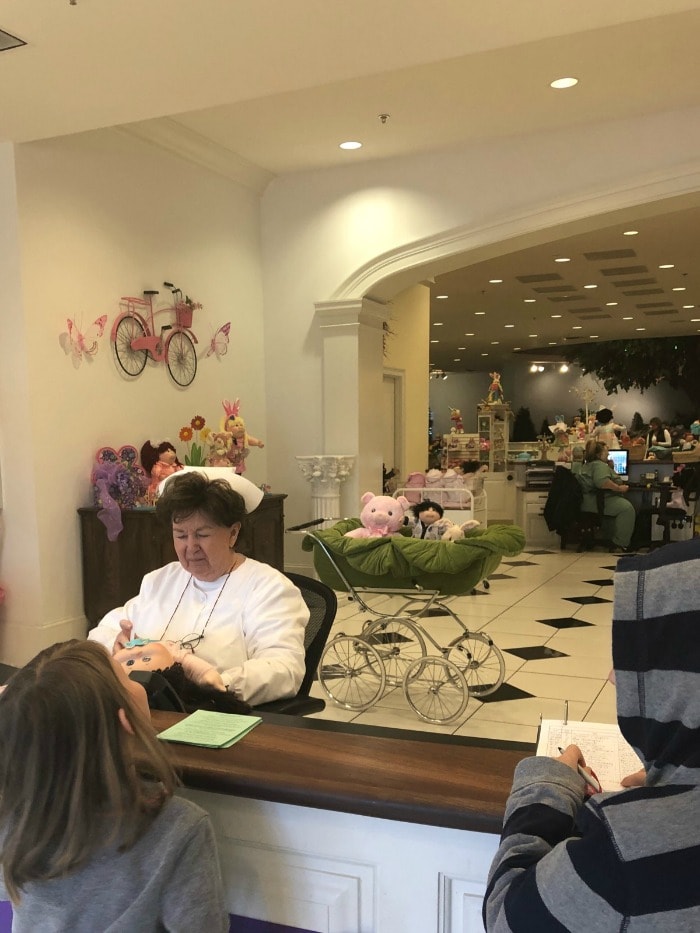
After sign in, there’s an opportunity to take a photo in a giant plush cabbage. Who can resist?

As soon as we rounded the corner and entered the rooms filled with posed dolls in cribs, changing tables and strollers, I started giggling. It was a confused, weirded out, excited sort of giggle. What in the world WAS this place?
The fun really started, however, after I paid top dollar for my daughter “adopted” her very own Cabbage Patch doll. An announcement was made over the intercom that it was time for Mother Cabbage to give birth! We quickly made our way over to the huge tree in the middle of the main room. The crystals were glowing, which apparently, means it’s baby time.
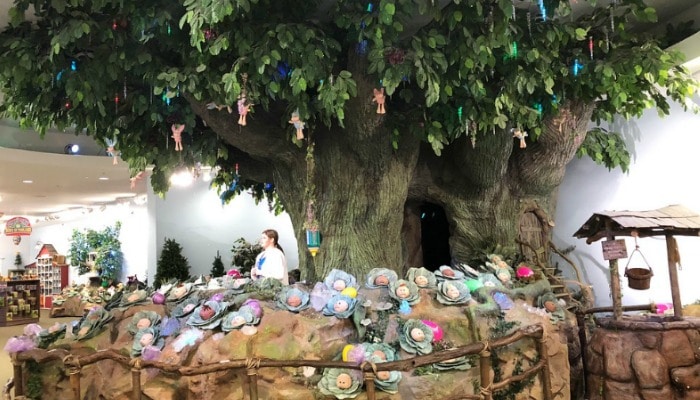
Before You Leave a Comment (Read the Whole Article)
Before I dive into the birthing culture of BabyLand General Hospital, let me just say a few things. Yes, I know this place is for children and much of what is said goes over their heads. Yes, I know that what goes over their heads is mostly intended for the amusement of parents.
However, as someone that works professionally with pregnant women and their partners (meaning I’ve got my eyes and ears on the ground), one of the consequences of poorly teaching our children about childbirth is that women are learning about birth the hard way, through trial and error in their first birth experience. Unfortunately, too often women discover the benefits of evidence-based birth practices by experiencing the opposite. Not only do these women suffer, but their partners and children suffer, too.
Childbirth education does not suddenly start when a parent has “the big talk” with their child. Childbirth education happens all throughout childhood, directly and indirectly, conscious and subconsciously, whether we like it or not. Even silly cabbage patch birthing shows imprint on our children about how to give birth and mother their children.
Think about it. What were your first thoughts, ideas, and images about birth and babies? Where did those ideas come from? Some of us may say friends, some family, and potentially worse of all – Hollywood. Odds are, the most impactful things that shape our beliefs about birth are not at the kitchen table having “The Talk” with mom or dad.

Our Children are Watching and Learning
While waiting to pay a lot of money take the oath of “adoption,” my two oldest overheard a conversation between a BabyLand LPN (licensed patch nurse) and another “adoptive parent.” They found out that if your baby is sick, you can bring them back to the hospital to get better. Much to my daughter’s dismay, she discovered that cabbage dolls are prone to frogs in their throats and bubbles in their tummies.
The thing is, as far as my daughter is concerned, what she heard from the LPN is FACT. She now believes that as a mother, she is to be on the lookout for sickness in her new baby, manifesting in frogs and bubbles. I’m telling you, it was as if she heard the very word of God.
I’m not saying we shouldn’t pretend and have fun with our children. Of course we should! It’s so much fun! My point here is that our children are listening, learning, and soaking everything up. And because our children are sponges, after reading the rest of this article, I want you to ask yourself this question:
Are the underlying assumptions about giving birth, as presented by BabyLand General Hospital and elsewhere in our society, what we want our children to believe to be true about giving birth (one of THE most memorable moments in a person’s life)?
BabyLand’s Birthing Culture
The following are a few things that stood out to me about BabyLand’s birthing culture that need a little update. Let’s get started!
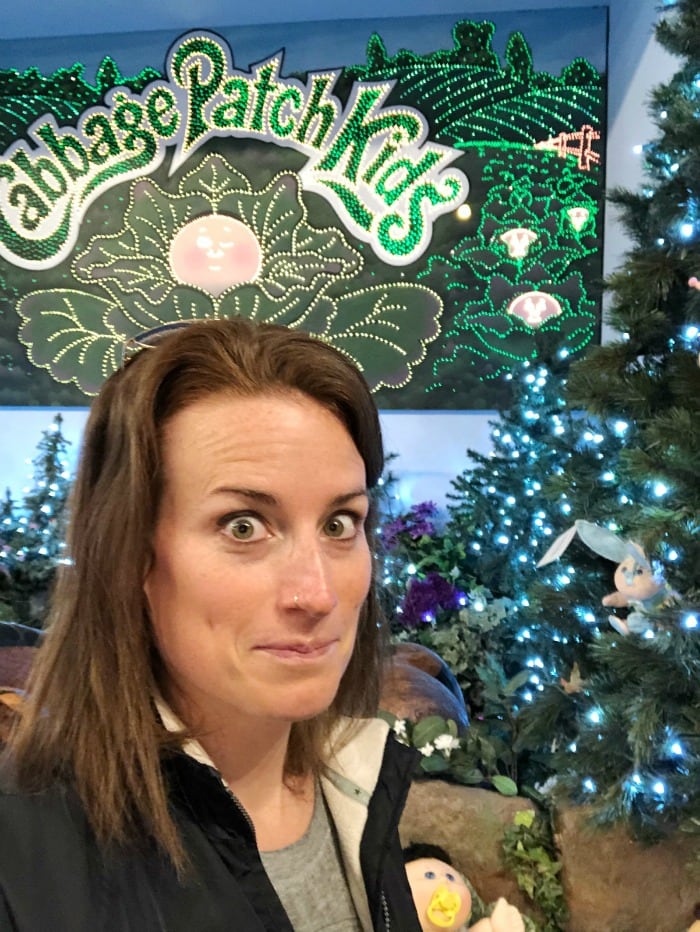
Medically Unnecessary Ultrasounds
Before each cabbage patch doll birth, an LPN performs an ultrasound on Mother Cabbage to determine the sex of the baby before its born. It’s cute and a fun way to engage the audience. I get why they do it!
However, we are teaching and enforcing the belief that ultrasounds can be used for entertainment purposes. In my opinion, ultrasounds should only be used when medically necessary. If there is no medical reason to receive an ultrasound, we should not partake.
The reason I say this is because the risks of ultrasound have not been fully researched. In one study it has been found that ultrasound increases the chance of left-handedness. It’s not that left-handedness is bad, it’s that something about ultrasound is altering our children’s bodies. This concerns me! Even the FDA cautions against it!
What if instead of performing an ultrasound before a cabbage patch doll is born to see the sex of the baby we used a fetoscope to listen to the heartbeat instead? I bet that would engage the audience in a similar way!
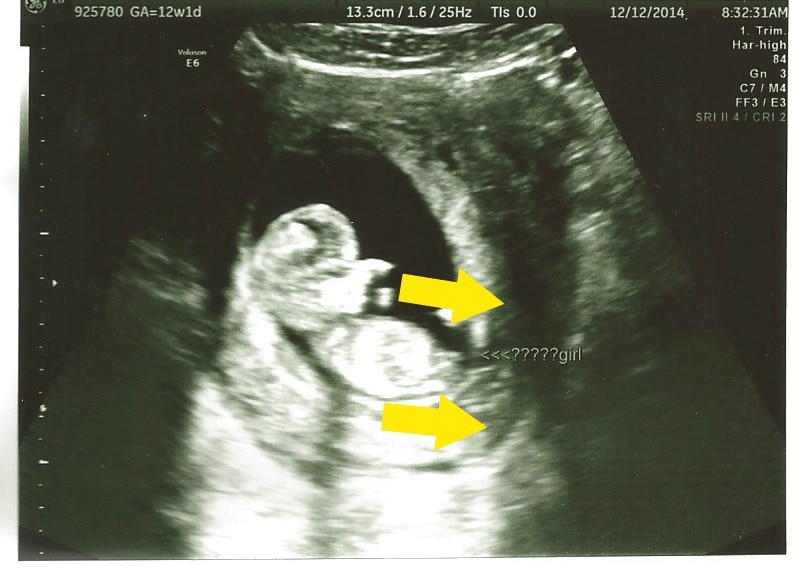
Medication is Necessary to Give Birth
Another “procedure” that stopped me in my tracks was when the LPN administered two different medications right before delivery. The first one was “a big dose of imagicillin” of which we were told “it doesn’t harm her, just helps her to relax and loosens her leaves.” The second medication was a “big dose of TLC.” Both were administered with a syringe and/or via an IV.
The underlying impression here is that the use of medication is a necessary part of giving birth.
Again, I’m not against the use of medication during birth. Personally, I’ve used antibiotics for Group B Strep and Pitocin at my births, and fully support women in their choices with pain medication for birth, even if they were originally planning for a natural birth.
However, by using medications when it absolutely, positively does not need to be a part of the birthing show script, these young, impressionable children, therefore, may now believe that receiving medications during birth is just how things are done.
Also, the doula in me balked at the explanation of the imagicillin. I realize that it’s ridiculous for me to expect the LPN to give informed consent to Mother Cabbage and the audience, however, it bothered me because these are the types of superficial explanations many women receive when they question their care provider’s choices.
I refrained from using the B.R.A.I.N. acronym with the LPN. 😉
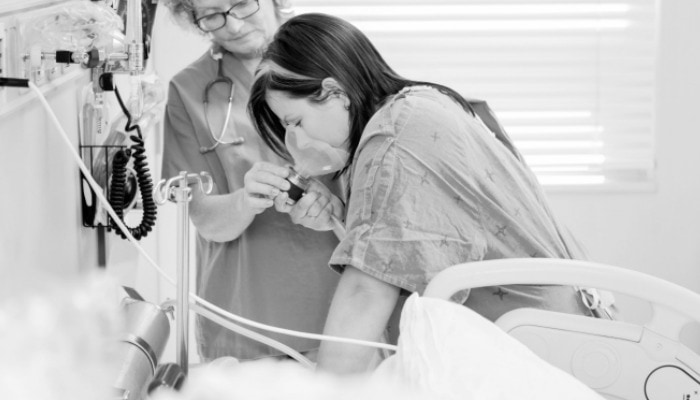
Breath Awareness
I did like, however, when the LPN coached the audience and had us participate in some breathing exercises. The LPN told us that “Mother Cabbage has been having babies all day and is veeeeeeeery tired and stressed out. We need to help her out by taking some slow, deep breaths.”
It was nice when we all took deep breaths together as a group. I love it when, as a culture, we are more present and aware, and an easy way to get to get there is through our breath.
In my childbirth classes, I teach a basic pain coping practice called Breath Awareness. Not only is this labor breathing technique excellent for a natural birth, but it’s also amazing for a medicated or even a cesarean birth.

Leave it to the Professionals (External Locus of Control)
At this point, it became clear to me why this birthing show bothered me so much. Right before delivery, the LPN used calipers to determine dilation while saying, “Mother Cabbage is dilated to 10 cabbage leaves apart which is a sign we can start our procedure”.
No, checking dilation doesn’t bother me, even though it is best to remember that the vagina is not a crystal ball. What bothered me was that Mother Cabbage was not a participant in her own birth process. She needed to be told what to do and when, as if a cabbage had no way of giving birth without the assistance of “a professional.” (Yes, I realize how ridiculous this sounds.)
It reminded me so much of the birth scene in Monty Python’s The Meaning of Life. Have you seen it? It’s hysterical. And sad.
The underlying assumption we teach our children is that during pregnancy and birth, instead of an internal locus of control, what’s best is an external locus of control. When it comes to birth, we’re taught that it’s best to leave it up to the professionals and not be involved in the decision-making process.
However, did you know that research shows the more a woman is part of the decision-making process during birth, she will be happier about the outcome, no matter what happens?
“It is also suggested that active involvement of pregnant woman in decision-making process for the delivery method will increase the rate of vaginal birth after c-section and decrease c-section rate and improve the degree of maternal satisfaction after delivery.”
Plain and simple, if a woman is ignored she will be unhappy about her experience giving birth, which can have long lasting consequences in the way she mothers, her self-esteem and future pregnancies (among other things).
Perhaps the birthing script could be altered to something as simple as Mother Cabbage has told us that she’s ready to push. I think this shift in language would make a big impact.

Coached Pushing
Once Mother Cabbage’s leaves were fully dilated, she was deemed ready to push by the LPN. At this point, everyone was asked to yell “PUSH!” a few times to help get the baby out. Again, I get why they did this – crowd involvement is fun!
However, for many women coached pushing not only reinforces an external locus of control, but it doesn’t actually do any good. The research shows that coaching women through the second stage of labor does not benefit them in any way.
In my experience coached pushing seems to leave mothers and babies with less oxygen and higher stress levels. It seems that birth often works best when women are allowed to listen to their bodies and follow their instincts. Women are amazing!
If I had to guess what one of the things my children remember most from the birthing show it would be yelling “PUSH!” at Mother Cabbage. Perhaps instead the audience could say various birth affirmations or words of encouragement?
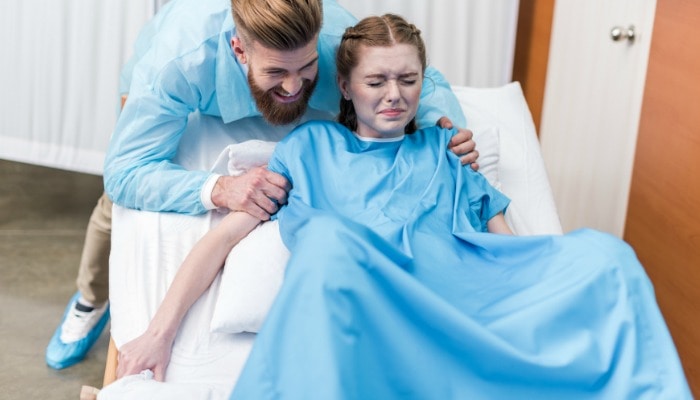
“You can do it!”
Easy-otomy
Mother Cabbage’s “easy-otomy” was probably the most ridiculous part of Mother Cabbage’s birth. Yes, this went right over the children’s head and was intended to make parents chuckle, but I’m sorry, making light of a cut perineum isn’t really that funny to me.
Perhaps with this one we’re not teaching our children anything, but what we are doing is reinforcing to adults that genital tract trauma is unavoidable and that an intact perineum is not possible. This is simply not true.
I’m not sure its necessary to replace the “easy-atomy” with anything in the birth script. Just pull it!
If you would like to learn more about how to prevent tearing at birth, head on over here.

Immediate Cord Clamping
Another birthing practice that went right over the children’s heads was the immediate cutting of the umbilical cord. There was no cord that was seen, but the LPN talked us through the procedure while she was doing it.
In recent years, research has come out in support of Delayed Cord Clamping. Delayed Cord Clamping is the practice of postponing cutting a newborn’s umbilical cord instead of immediately cutting it after birth.
Delayed cord clamping is awesome! It…
- Allows babies to have full access to the blood they were meant to have
- Decreases anemia in the first year of life helping babies to get smarter faster
- Can be done in a minute (preferably until the cord has stopped pulsing!)
- Can help premature babies to stay healthy
- Is what nature intended!
According to Academic OBGYN, and the source for this article, “It is not our job to prove that immediate cord clamping is safe. But to prove that immediate cord clamping is not dangerous.”
Wouldn’t it be amazing if instead of the LPN talking us through the immediate cutting of the cord, she spoke about the benefits of delayed cord clamping? A childbirth educator can dream. 🙂
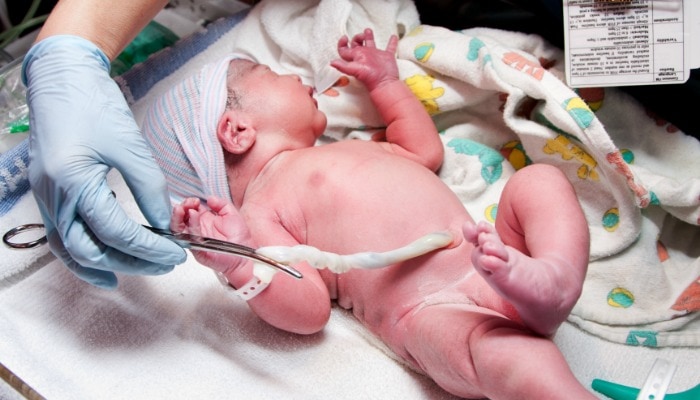
Spanking Baby Upside Down
Next, the LPN held the freshly born cabbage patch upside-down by its feet and (gently, I will add) spanked its butt. What in the world? Parents chuckled, the kids said nothing, and I was horrified.
Really, BabyLand? Spanking an upside-down baby after birth to stimulate and clear its lungs is an antiquated practice, I think we can all agree on that.
I don’t know what else to say besides NO and show you a picture of a cute upside-down baby. I didn’t have it in me to include a picture of a newborn getting spanked as its welcome to the world. :/

Swaddling
Eventually the baby doll was swaddled in preparation for its next adventure, which unfortunately wasn’t skin-to-skin with Mother Cabbage. Honestly, I have no idea what that would even look like between the two, but I figured while we’re going through the best birthing practices, it’s important to discuss skin-to-skin during the first hour of life.
Swaddling is helpful because it calms babies and makes them feel cozy just like they were back in the womb. I even teach my childbirth classes proper swaddling technique because swaddling a baby is the first step to calming a baby. But just because something is helpful, does it mean that it’s the best thing right after birth?
By definition, a baby who is swaddled has none of its skin touching its mother and none of the mother’s skin is touching the baby. What a tragedy!
In my opinion, babies should be swaddled only if they are not being held, which shouldn’t be the case during that first hour. If baby gets swaddled and handed to you, simply unswaddle and place baby on your chest. Again, the best place for baby to be after birth is on mom’s chest, skin-to-skin.
The photo below shows a mother with her brand new baby in the OR. Skin-to-skin is possible even in the OR!
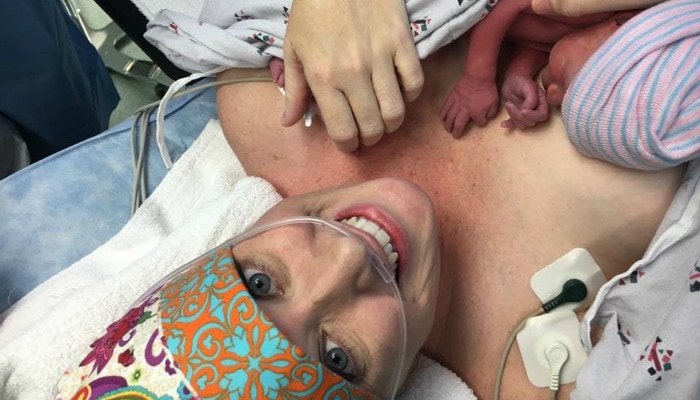
Baby Nursery
After the brand new cabbage patch baby was swaddled, it was brought to the nursery for heart testing and vaccinations. This was fun for the kids as they got to see this baby through the glass. It made the whole thing seem very real!
The thing is, however, that taking a baby to a baby nursery is also an antiquated practice. At the hospital I teach childbirth classes at, the baby nursery is pretty empty. Instead, rooming in with parents is encouraged.
However, even if we keep the baby nursery part of the show, I do think what happens there could be tweaked a bit. For example, why are we vaccinating a brand new baby (doll)? No matter your views on vaccinations, I think this is one of the routine newborn procedures we could delay until after the first hour (and therefore remove from BabyLand’s birth script). There’s no need to teach our children that as soon as a human is born it must be taken from their parents and immediately inoculated.
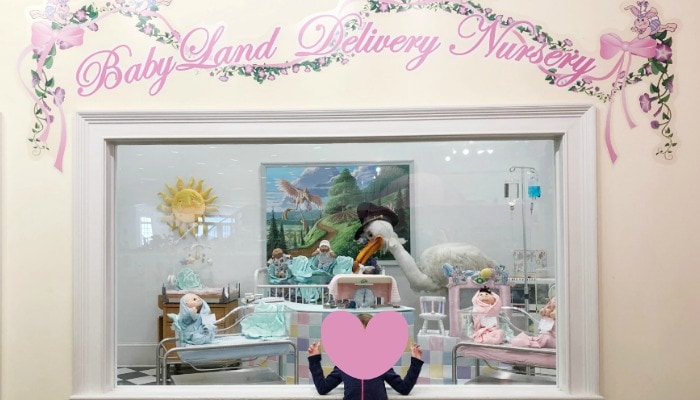
BabyLand General Hospital – Cleveland, GA
BabyLand, coming to your hospital was a dream come true for my children, especially my five year old. We had a wonderful time and if we’re ever in the area again, we will definitely be back. We’re big fans!
I hope that this article highlights the potential for your organization to impact the next generation’s perception of birth. How we give birth matters and therefore how and what we teach our children about birth matters, too.
Please consider changing your birthing script to reflect a more modern, compassionate, and evidence-based model of care. Don’t miss this opportunity – the next generation is worth it and they are always watching and learning from us!
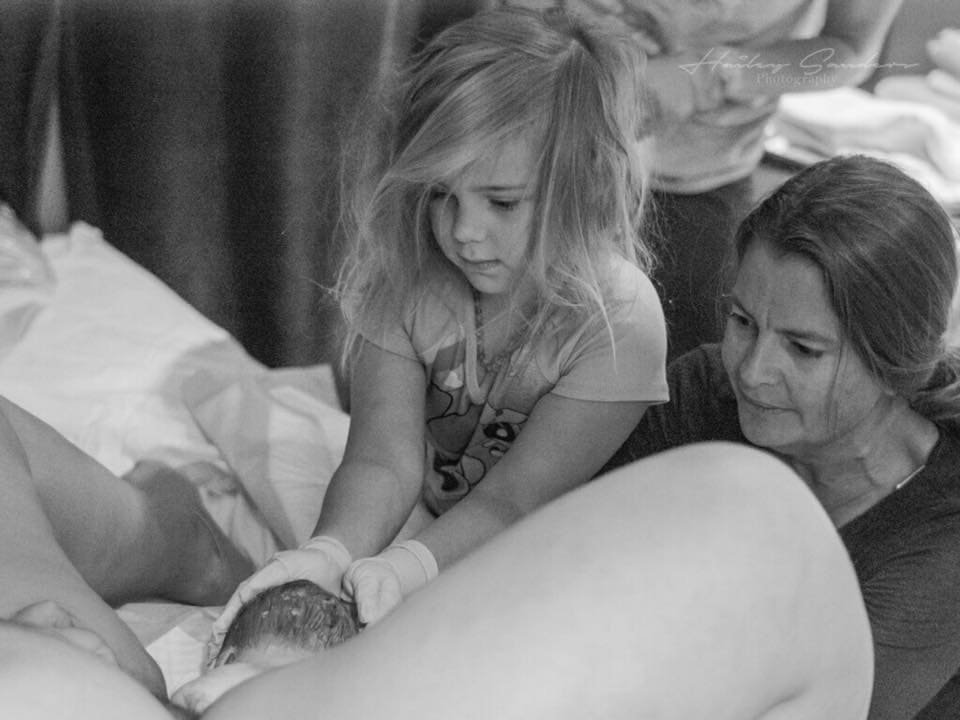
Photo Credit: Mother to Mother Midwifery


Amanda
Friday 27th of July 2018
I think you are over thinking it and if your child truly believed any of this not just playing along one talk to kid honestly and 2 if still on odd wave length of stuff get the kid a shrink.